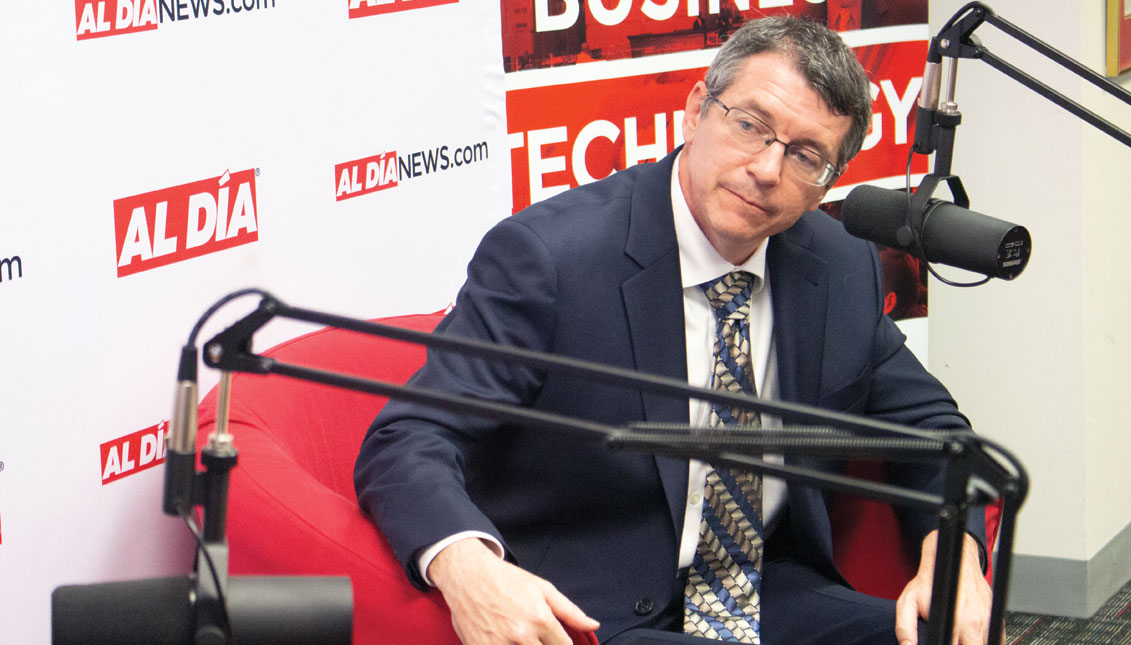
The green future of Pennsylvania
Cities, states, and even corporations are fighting climate change in the absence of national legislation. Patrick McDonnell, Secretary of the Department of…
Though President Trump has withdrawn the U.S. from the international climate accords - such as the Paris Agreement, which has been signed by more than 200 countries - states such as Pennsylvania are picking up where the Obama Administration left off in order to fight the effects of a force that looms over the country - and the world as a whole.
While much of today's national debates go through the filter of radical bipartisanship, issues such as the Green New Deal percolate into deeper spheres.
The Trump Administration has devoted significant efforts towards the lifting of environmental regulations from the Obama era, without putting in place substitute plans that give some coherence to their policies.
However, states such as Colorado, New Mexico, Hawaii, New York, and California have put in place strategies for the control of methane emissions, the prohibition of certain pesticides and so-called "forever chemicals," whose aggressive impact on the environment is a major cause of thyroid disease and cancer.
The U.S. Climate Alliance, a bipartisan group of 24 governors committed to meeting emissions reduction goals laid out by the Paris Agreement, which President Trump withdrew from in June 2017, now represents more than half of the U.S. population, and 60 percent of the country’s GDP.
Though the tide has turned for many, there are still holdouts that feel climate action at the federal level could hurt the economy and result in a loss of jobs.
Faced with the firm proposal of the Green New Deal to recover the workforce and transform the infrastructure into a sort of job mine, some unions aren't entirely on board.
The AFL-CIO, for example, recently spoke against the proposal.
As the largest federation of labor unions in the United States (with some 12.5 million workers), the organization criticized the fact that the green economy project hasn't included them in the process.

"We want many changes to be made so that workers and our jobs are protected in the process," said Richard Trumka, president of the federation.
This opposition to one of the main foundations of the Green New Deal puts in check the support that 2020 Democratic candidates may or may not obtain, knowing those job opportunities are a critical factor in the approval of voters.
According to recent polls, among 1,914 registered voters, 48 percent said they support the Green New Deal resolution, which represents nearly half of the public support.
However, most of the respondents said they supported a proposal focused only on climate change.
Party representatives such as Senator Ed Markey (D-MA) and Rep. Alexandria Ocasio-Cortez (D-NY) have emphasized that the proposal focuses on social justice and equal opportunities, but the skepticism of the unions and voters is profoundly contradictory.
But in the absence of national legislation, states, municipalities, and the private sector alike have ramped up efforts to address adaptation and mitigation of climate change.
In the state of Pennsylvania, the immediate effects of global warming have meant a 1.8 percent increase in temperature over the past century - and a projected 5.4 percent exponential increase in average temperature by 2050.
Other impacts include increased precipitation, and increased intensity of rain events, a factor which the Secretary of the Department of Environmental Protection of Pennsylvania, Patrick McDonnell, said is particularly significant in thinking about flooding and how to adapt infrastructure to prevent floods and better drain stormwater. The state has seen an overall 10 percent increase in the amount of precipitation in a year over the last century and is expected to see a 10 percent increase in the yearly amount of precipitation by 2050.
The number of disease-carrying pests in the Keystone state has also increased. With more standing water, mosquitoes carrying diseases such as the West Nile virus are able to breed; and another danger is ticks carrying Lyme disease - a particular issue for Pennsylvania, said McDonnell, which has seen the most cases of Lyme disease of any state in the nation.

Appointed to the position by Gov. Wolf in 2016, McDonnell has worked at the DEP for the majority of its existence, first starting there as an intern in 1997. The DEP was first established in 1995, when the former Department of Environmental Resources was split into the Department of Environmental Protection, to focus on regulatory measures and environmental protection, and the Department of Conservation and Resources, currently headed by Cindy Dunn, which oversees the management of the state’s park system.
The DEP secretary said that in the time he has been working at the DEP, he has seen the conversation around climate change and environmental justice shift in terms of the use of technology to promote greater understanding and pinpoint climate issues as they affect most Pennsylvanians, as well as a greater emphasis on inclusion, at the level of local communities, in developing climate action strategies.
On April 29, McDonnell stood alongside Gov. Tom Wolf as he announced that Pennsylvania would join the U.S. Climate Alliance, a bipartisan group of now 24 state governors that are committed to reaching the emissions goals and other objectives outlined in the Paris Agreement. In accordance with goals made by the U.S. Climate Alliance the landmark international agreement, which over 200 countries have ratified, Pennsylvania has committed to getting to a 26 percent reduction of greenhouse gas emissions by 2025, and an 80 percent reduction by 2050.
RELATED CONTENT
The state also released the 2018 Climate Action Plan in April, a report the state must produce every three years under the Climate Change Act. The plan highlights the impacts that global warming and climate-related events have had on residents throughout the state and makes recommendations through 19 specific strategies for more than 100 actions on the part of legislators, business owners, and executives, and households to move toward sustainability.
Though McDonnell’s work involves communicating the sobering statistics associated with climate change and its effects both statewide and throughout the globe, he remains optimistic when assessing the role the state can play in mitigating climate change and assessing the impacts: he said he views a lot of the changes that need to be made as “incredibly feasible.”
“I think one of the positive things we say off the bat is a lot of the solutions we’re talking about are solutions that are ultimately helpful to the commonwealth, not just on the environmental but also economic and social dimension,” he noted, highlighting the fact that investment in energy efficiency and solar energy can create more jobs for state residents.
“Understanding the costs of climate change is key in linking the economic piece to why climate action matters,” McDonnell explained, citing the example of the fact that PennDOT had to spend over $100 million to address flooded bridges and waterways in the last year.
“Those are costs that we’re bearing in order to repair things that are already there, as opposed to advance something else,” he continued. “So this has an economic component to it that can be positive, that can be negative, depending on how we address it.”
McDonnell said that the listening sessions the DEP has been holding are designed to better connect the state’s work on climate action with immediate needs from local communities - and by its nature, much of that means that people’s concerns touch on socioeconomic issues as well, such as food deserts, litter and waste, and more. But that contextualization of what climate change and its impacts mean in each community is the first step to establishing what sustainability at all levels would require, said McDonnell.
“If I’m talking to someone about litter and they’re worried about where their next meal is coming from, it’s really hard to have that conversation. So we need to meet people where they’re at in terms of the experience that they’re having and be attentive to that and listening to that in order for us to achieve the variety of things we want to achieve as state government,” he said.
McDonnell and the DEP has also taken action recently to regulate another environmental concern which is often regulated at the federal level: safe drinking water.
The state has seen up to 21 different locations of drinking water that have been contaminated by perfluorinated compounds. The contamination historically has come from firefighting foams which were used at military and air bases to put out fires and then leaked into ground water.
The state is now in the process of doing sampling at 400 locations throughout the state, 90 percent of which are sites where they “expect” to find some contamination, said McDonnell. They also plan to establish a maximum contaminant limit, which would serve as the drinking water limit for two of the chemicals being tested for (PFOS and PFOA).
“Ultimately what we’re making is a regulatory decision, so we need to have the science, the economic basis in order to be able to support that decision,” said McDonnell, who noted that all sampling information will be released on a quarterly basis and the DEP will take “immediate actions” to treat water sources that are found to have contamination above the seventy parts per trillion, the only federal guideline that is a health advisory limit put out by the Environmental Protection Agency.
McDonnell said that the establishment of a safe drinking water standard and action are climate change “are good examples where we as states have had to pick up where there was probably properly a role for the federal government.”
“I mean the science around climate is well-settled now, it really is about how we address it, and how we...move those solutions forward in a way that can be supportive of us as a state,” he continued. “It is better regulated at the national level, by walking away from clean power plants and some other things, the Paris Agreement, those are things that don’t exist at the federal level right now, and the states are doing our best to make sure we’re addressing it.










LEAVE A COMMENT:
Join the discussion! Leave a comment.